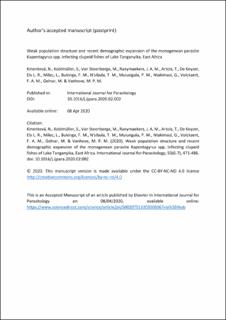Weak population structure and recent demographic expansion of the monogenean parasite Kapentagyrus spp. infecting clupeid fishes of Lake Tanganyika, East Africa
Kmentová, Nikol; Koblmüller, Stephan; Van Steenberge, Maarten; Raeymaekers, Joost A.M.; Artois, Tom; De Keyzer, Els L.R.; Milec, Leona Johanna M.; Bukinga, Fidel Muterezi; N'sibula, Theophile Mulimbwa; Mulungula, Pascal Masilya; Ntakimazi, Gaspard; Volckaert, Filip A.M.; Gelnar, Milan; Vanhove, Maarten P.M.
Peer reviewed, Journal article
Accepted version
Permanent lenke
https://hdl.handle.net/11250/2728413Utgivelsesdato
2020Metadata
Vis full innførselSamlinger
Originalversjon
Kmentová, N., Koblmüller, S., Van Steenberge, M., Raeymaekers, J.A.M., Artois, T., De Keyzer, Els L.R., Milec, L., Bukinga, F.M., N'sibula, T.M., Mulungula, P.M., Ntakimazi, G., Volckaert, F.A.M., Gelnar, M. & Vanhove, M.P.M. (2020). Weak population structure and recent demographic expansion of the monogenean parasite Kapentagyrus spp. infecting clupeid fishes of Lake Tanganyika, East Africa. International Journal for Parasitology, 50(6-7), 471-486. doi: 10.1016/j.ijpara.2020.02.002Sammendrag
Lake Tanganyika, East Africa, is the oldest and deepest African Great Lake and harbours one of the most diverse fish assemblages on earth. Two clupeid fishes, Limnothrissa miodon and Stolothrissa tanganicae, constitute a major part of the total fish catch, making them indispensable for local food security. Parasites have been proposed as indicators of stock structure in highly mobile pelagic hosts. We examined the monogeneans Kapentagyrus limnotrissae and Kapentagyrus tanganicanus (Dactylogyridae) infecting these clupeids to explore the parasites’ lake-wide population structure and patterns of demographic history. Samples were collected at seven sites distributed across three sub-basins of the lake. Intraspecific morphological variation of the monogeneans (n = 380) was analysed using morphometrics and geomorphometrics of sclerotised structures. Genetic population structure of both parasite species (n = 246) was assessed based on a 415 bp fragment of the mitochondrial cytochrome c oxidase subunit I (COI) gene. Overall, we observed a lack of clear geographical morphological differentiation in both parasites along a north–south axis. This lack of geographical population structure was also reflected by a large proportion of shared haplotypes, and a pattern of seemingly unrestricted gene flow between populations. Significant morphological and genetic differentiation between some populations might reflect temporal differentiation rather than geographical isolation. Overall, the shallow population structure of both species of Kapentagyrus reflects the near-panmictic population structure of both host species as previously reported. Morphological differences related to host species identity of K. tanganicanus were consistent with incipient speciation at the genetic level. Both parasite species experienced a recent demographic expansion, which might be linked to paleohydrological events. Finally, interspecific hybridisation was found in Kapentagyrus, representing the first case in dactylogyrid monogeneans.

